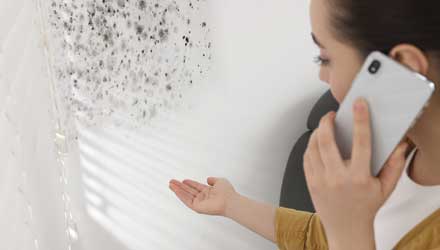By Sophie Neaves on Tue 05 March 2024 in Blog
The importance of Awaab's Law and how to meet the new requirements
Awaab’s Law is part of the biggest government reforms affecting both social and private housing in a decade. It brings about changes to ensure tenants in rented accommodation are protected from the damaging effects of damp and mould. Addressing issues with social landlords not complying with rules and regulations, it enforces timely action to prevent health hazards and rectify any issues within specific timeframes.
In this guide, we discuss what Awaab’s Law is, what it means for landlords, and how requirements are met.

What is Awaab’s Law?
Awaab’s Law will require social housing landlords to adhere to strict time limits to address dangerous hazards such as damp and mould in their properties, and forms part of the Social Housing (Regulation) Act.
Awaab’s Law came about following the death of two-year-old Awaab Ishak from Rochdale who died due to a respiratory condition brought on by extensive mould in the social housing he was living in. Despite the family reporting mould to the landlord, no action had been taken to treat the issue in the three years between the notification of mould and Awaab’s death.
This son to be enforceable legal requirement aims to help prevent future tragedies and protect the health and safety of others. Social landlords will be required to take swift action to remedy any reported damp or mould and show every attempt to comply within the given timescale.
Under the government’s new guidance on the health risks of damp and mould for landlords, tenants will not be held accountable for the presence of mould or damp in their homes. It will no longer be blamed on the ‘lifestyle choices’ of the tenants in the property, and it is recommended an investigation and repair work should be carried out by landlords as soon as possible within a fixed period.
What does Awaab’s Law mean for landlords?
The Department for Levelling Up, Housing and Communities (DLUHC) has published guidance to social landlords. This guidance urges landlords to ensure all properties meet the Decent Homes Standard, gain awareness of any properties that don’t meet the standard and undertake rapid maintenance where necessary.
Landlords are expected to undertake an assessment of:
- Damp and mould issues within the property, including the prevalence of category 1 and 2 damp and mould hazards
- A required action for any damp and mould issues.
- If, through these assessments, you become aware that you may be in breach of regulatory standards you should self-refer to the Regulator of Social Housing.
Awaab’s Law will mean that social housing landlords must:
- Begin investigating known or reported hazards within 14 calendar days.
- Provide a report in writing within the 14-day timeframe that includes information about the hazard, the solution to address the hazard, and a clear timeframe to remedy the issue.
- Repair work should begin within 7 calendar days if the hazard is defined as a significant risk to the health or safety of the tenants (guidelines set out by the government help define this) with consideration about the vulnerability and age of tenants.
- Repair work should be completed within a ‘reasonable time period’ as defined in the Landlord and Tenant Act 1985.
- 24 hours is the timeframe for emergency repairs.
- Alternative accommodation should be offered by social housing landlords if repairs cannot be completed in the above timeframes.
- A clear record of all correspondence between residents and contractors is required to be kept by social housing landlords.
- These new rules should form part of a tenancy agreement, so tenants can hold landlords accountable by law.
Latest developments
Awaab’s Law originally entered parliament through Clause 42 within the Social Housing (Regulation) Act in July 2023. It forms part of the government’s White Paper pledge to reduce non-decency in rented homes by 50% by 2030.
Following the introduction of the Private Renters Rights Bill, Awaab’s Law will extend beyond social housing to include the private rental market. Originally expected to come into action before the end of 2024, the government have faced criticism from charities for not acting sooner to protect vulnerable people, announcing in early February that the law would not be enforced in the social housing sector until 2027. In response to this backlash, the government has now set October 2025 as the official date that the law will apply to the social housing sector, leaving landlords with little time to finish retrofitting their properties to meet the new regulatory standards.
What about the enforcement of Awaab’s Law?
Once enforceable, if social landlords do not meet the timeframes specified in Awaab’s law, residents will be able to take them to court.
With the law’s extension confirmed for October 2025, landlords need to take a proactive approach to preventing damp and mould issues in their properties.
The Social Housing (Regulation) Act 2023, however, which became law in 2023, gives tenants stronger powers and rights to hold landlords accountable. The Regulator will be given the power to issue unlimited fines and enter properties with 48 hours' notice if emergency repairs are required.
How to meet the requirements of Awaab’s Law
It is now the landlord’s responsibility to identify and address the underlying causes of damp and mould. This could relate to inadequate ventilation or structural issues, so finding a solution is crucial, be that a ventilation system or adjustments to the property to rectify any issues.
To ensure you are meeting the requirements of Awaab’s Law, proper ventilation and good quality air flow should be assessed, avoiding mould and damp issues in social housing.
Although reactive maintenance is important, proactive planning should also be a key focus for both private and social housing landlords. To avoid damp and mould in their current properties and future, landlords should keep the wellbeing of their residents and their compliance with regulated living standards front of mind.
With over 60 years of experience and a highly effective range of solutions, including intermittent extractor fans, constant running extractor fans, heat recovery ventilation and retro-ducting systems, Airflow Developments has solutions for all your needs. Learn how we can help you find tailored ventilation solutions and maintenance services to meet your specific requirements as a social housing landlord.
How Airflow can help
As specialists in ventilation, we understand your challenges, and it’s our mission to future-proof your homes to make them damp and mould-free. Our skilled technicians can help you find the most suitable home solutions using BIM models, Selectair software and specialist system design advice. Consult with us at the early stages of your development, and your costs will be minimised.
We also offer reactive maintenance services to fix any issues quickly, allowing you to fulfil your legal obligations regarding indoor air quality and rectify any damp or mould issues, safeguarding your tenants’ health and your property. Get in touch for more information.


